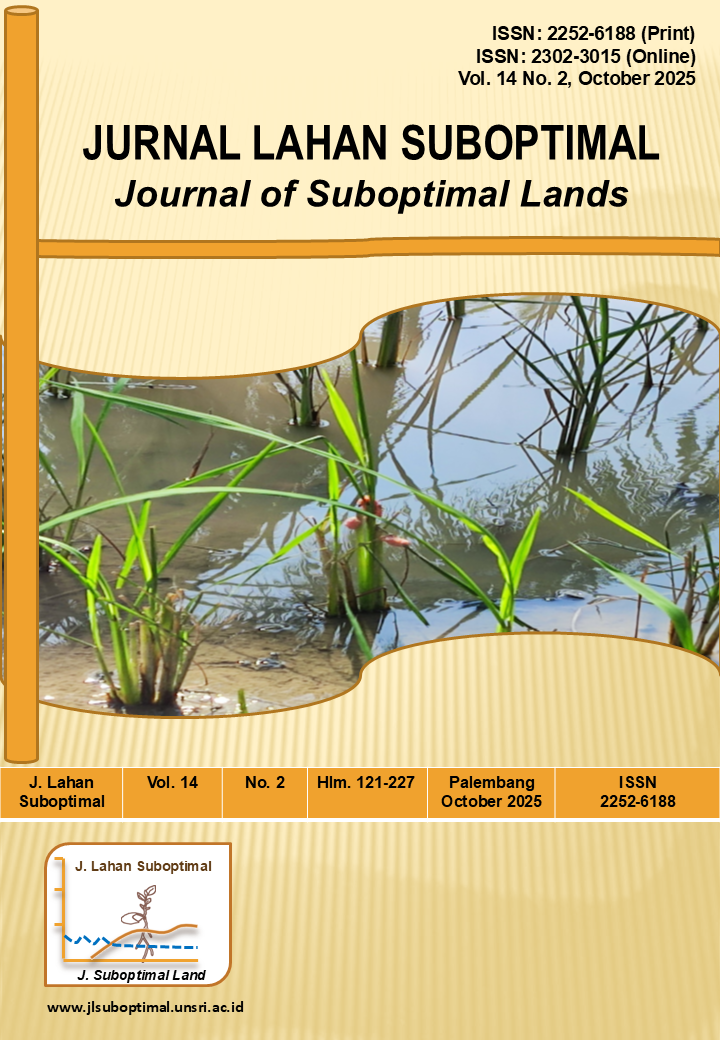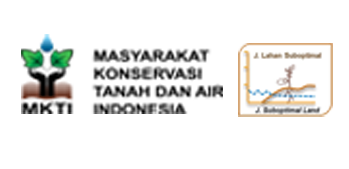Diversity insect in the Vegetative Phase of Arenga pinnata (wurmb) merr. in Tanjung Miring Village, Muara Enim
DOI:
https://doi.org/10.36706/jlso.14.2.2025.746Keywords:
Arenga pinnata, insect, population, pitfall trap, yellow sticky trapAbstract
One of the factors that support the growth of sugar palm plants was the presence of insects that indirectly play an important role in the ecosystem of these plants. The study aimed to determine the abundance, diversity, and role of insects associated with young sugar palm plants (vegetative) in Tanjung Miring Village. The method used was purposive random sampling by setting yellow sticky traps and pitfall traps. Data collection techniques were obtained through direct observation in the field by setting two traps and interviews with sugar palm plant farmers using a questionnaire. The results showed that there were 21 insect species belonging to 18 families from 8 orders. Three important insect groups consisted of 9 types of pollinating insects, 7 types of herbivorous insects, and 5 types of decomposing insects. The abundance of pollinating and decomposing insects was dominated by the orders Hymenoptera and Diptera with a total of 338 individuals. The highest insect species diversity was found in the yellow trap with 13 species and a Shannon-Wiener diversity index (H') of 2.17. While pitfall traps, only 8 species of insects were found with an H' value of 1.43. The high diversity and abundance of yellow traps showed the dominance of active flying insects, especially pollinators, with the highest relative abundance (Di=2.43). The complex ecosystem of the sugar palm groves is an important habitat for various insects with complementary ecosystem functions.
References
Aliyu, I., Sapuan, S. M., Zainudin, E. S., Rashid, U., Zuhri, M. Y. M., & Yahaya, R. (2023). Characterization of ash from sugar palm [Arenga pinnata (wrumb) merr.] Fiber for industrial application. Journal of Natural Fibers, 20(1), 1–14. https://doi.org/10.1080/15440478.2023.2170943
Bahrain, S. H. K., Masdek, N. R. N., Mahmud, J., Mohammed, M. N., Sapuan, S. M., Ilyas, R. A., Mohamed, A., Shamseldin, M. A., Abdelrahman, A., & Asyraf, M. R. M. (2022). Morphological, physical, and mechanical properties of sugar-palm (Arenga pinnata (wurmb) merr.)-reinforced silicone rubber biocomposites. Materials, 15(12), 1–16. https://doi.org/10.3390/ma15124062
Ghozali, M., Meliana, Y., & Chalid, M. (2022). Novel in situ modification for thermoplastic starch preparation based on Arenga pinnata palm starch. Polymers, 14(22), 1–12. https://doi.org/10.3390/polym14224813
Haryoso, A., Zuhud, E. A. M., Hikmat, A., Sunkar, A., & Darusman, D. (2020). Ethnobotany of sugar palm (Arenga pinnata) in the sasak community, Kekait village, West Nusa Tenggara, Indonesia. Biodiversitas, 21(1), 117–128. https://doi.org/10.13057/biodiv/d210116
Herlin, W., Fitriyani, D., Akbario, R., Aziz, M., Nurfadila, Y., Muhammad, G., & Rizkawati, V. (2024). Pollinator insects on sugar palm (Arenga pinnata Merr.) in South Sumatera, Indonesia. IOP Conference Series: Earth and Environmental Science, 1346(1), 1–13. https://doi.org/10.1088/1755-1315/1346/1 /012025
Ilyas, R. A., Sapuan, S. M., Atikah, M. S. N., Asyraf, M. R. M., Rafiqah, S. A., Aisyah, H. A., Nurazzi, N. M., & Norrrahim, M. N. F. (2021). Effect of hydrolysis time on the morphological, physical, chemical, and thermal behavior of sugar palm nanocrystalline cellulose (Arenga pinnata (Wurmb.) Merr). Textile Research Journal, 91(1–2), 152–167. https://doi.org/10.1177/0040517520932393
Imraan, M., Ilyas, R. A., Norfarhana, A. S., Bangar, S. P., Knight, V. F., & Norrrahim, M. N. F. (2023). Sugar palm (Arenga pinnata) fibers: new emerging natural fibre and its relevant properties, treatments and potential applications. Journal of Materials Research and Technology, 24, 4551–4572. https://doi.org/10.1016/j.jmrt.2023.04.056
Jayawardana, H. B. A., Sarie, F., Agil, M., Saputra, S., Gita, R. S. D., Hammado, N., Purnomo, T., Sukwika, T., Juwanda, M., Sari, D. N. R., Yuniarti, E., & Purwandari, A. R. (2023). Ilmu lingkungan. In A. Asari (Ed.), Ilmu Lingkungan (Pertama).
Lidia, S., & Aleksander, D. R. P. T. J. (2022). The effect of trap color on catches of Monochamus galloprovincialis and three most numerous non-target insect species. Insect, 13(2200), 1–18. https://doi.org/10.3390/insects13030220
Ludwig, J. A., & Reynolds, J. F. (1988). Statistical Ecology. In Chapter 9 (pp. 107–202).
Muda, N. A., Muda, M., & Awal, A. (2024). Sugar palm (Arenga pinnata Wurmb Merr.): its potential, limitation, and impact on socio-economic development of rural communities in Malaysia. Journal of Natural Fibre Polymer Composites (JNFPC), 3(1), 2821–3289.
Muda, N., & Awal, A. (2021). Sugar palm (Arenga pinnata Wurmb Merr.): A review on plant tissue culture techniques for effective breeding. IOP Conference Series: Earth and Environmental Science, 715(1), 1–9. https://doi.org/10.1088/1755-1315/715/1/ 012016
Mujetahid, A., Dassir, M., Muin, A. V. F., Gautama, I., & Hatimah, H. (2023). Cost and income analysis of harvesting of aren sugar farmers in Kalobba Village, Tellulimpoe District, Sinjai Regency. IOP Conference Series: Earth and Environmental Science, 1253(1), 1–13. https://doi.org/10.1088/1755-1315/1253/1/012068
Nirawati, Restu, M., Kuswinanti, T., Musa, Y., Paembonan, S. A., Millang, S., Syahidah, & Larekeng, S. H. (2020). Morphological characteristics of Arenga pinnata merr. From Maros and Sinjai provenances in South Sulawesi, Indonesia, and its relationship with brix content. IOP Conference Series: Earth and Environmental Science, 486(1), 1–7. https://doi.org/10.1088/1755-1315/486/1/ 012080
Ong, S. Q., & Høye, T. T. (2024). Trap colour strongly affects the ability of deep learning models to recognize insect species in images of sticky traps. Pest Management Science, 81, 654-666. https://doi.org/10.1002/ps.8464
Ordoñez-Araque, R., Quishpillo-Miranda, N., & Ramos-Guerrero, L. (2022). Edible insects for humans and animals: nutritional composition and an option for mitigating environmental damage. Insects, 13(10), 1–13. https://doi.org/10.3390/insects13100944
Purwanto, I. K. E., Suriani, N. W., & Rondonuwu, A. T. (2020). Identification of dominant plants in forest ecosystems in some manado state university land as explorative learning reference. International Journal of Advanced Engineering, Management and Science, 6(8), 356–367. https://doi.org/10.22161/ijaems.68.1
Riyanto, R., Herlinda, S., Irsan, C., & Umayah, A. (2011). Abundance and species diversity of insect predators and parasitoids of Aphis gossypii in South Sumatra. Jurnal Hama dan Penyakit Tumbuhan Tropika, 11(1), 57–68. https://doi.org/10.23960/j.hptt.11157-68
Sampson, C., Turner, R., & Ali, A. (2021). Monitoring and Trapping With Sticky Traps. Journal Horticulture & Amenity, 63(3), 166–169. https://international-pest-control.com/ wordpress/monitoring-and-trapping-with-sticky-traps-whats-new/
Sánchez-Bayo, F. (2021). Indirect effect of pesticides on insects and other arthropods. Toxics, 9(8), 1-22. https://doi.org/10.3390/toxics9080177
Sherwani, S. F. K., Zainudin, E. S., Sapuan, S. M., Leman, Z., & Abdan, K. (2021). Mechanical properties of sugar palm (Arenga pinnata wurmb. Merr) glass fiber-reinforced poly (lactic acid) hybrid composites for potential use in motorcycle components. Polymers, 13(18), 1–20. https://doi.org/10.3390/polym13183061
Withaningsih, S., Parikesit, & Nurislamidini, H. (2021). Management strategies of palm sugar (Arenga pinnata) production on extreme landscapes of rongga, west Bandung regency. International Journal of Conservation Science, 12(2), 625–640.
Downloads
Published
How to Cite
Issue
Section
License
Copyright (c) 2025 Riko Firmanto, Weri Herlin, Yulia Pujiastuti

This work is licensed under a Creative Commons Attribution-NonCommercial-ShareAlike 4.0 International License.













